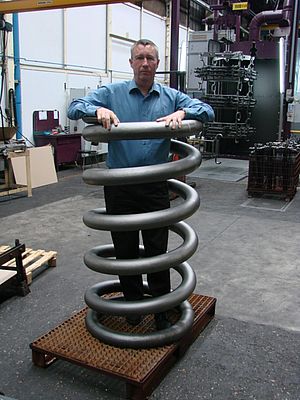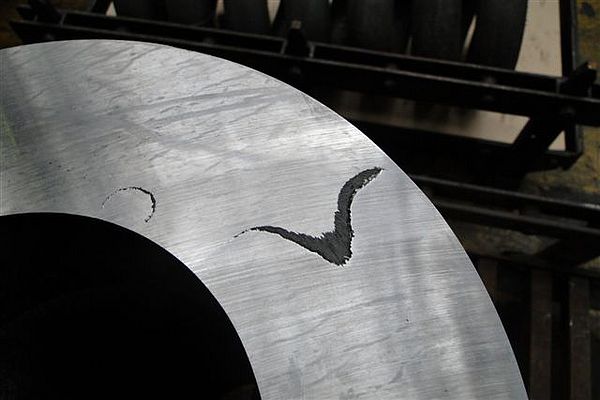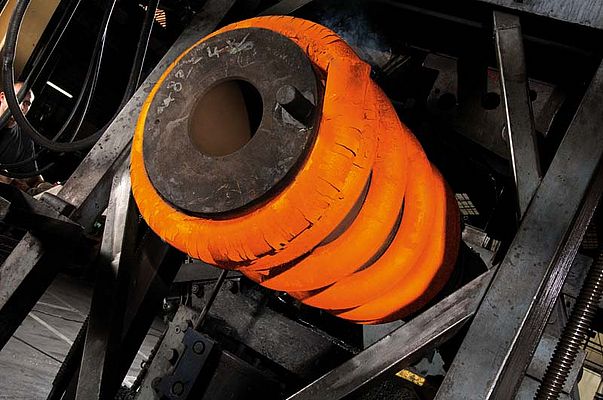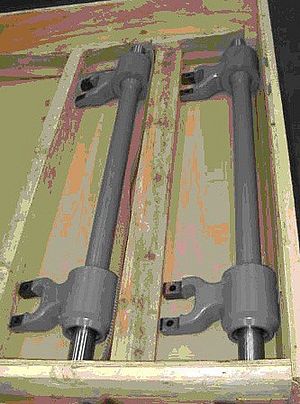When it comes down to engineering large springs, the technical dialogue between the manufacturer of springs and the customer is important to achieve good results. All parameters that will ensure proper operation of the spring loaded unit must be mentioned, because all problems will increase as the size of the spring increases.
By large springs, we must understand that one or more of the following criteria will be met :
- Wire diameter: Class 1 : 40 to 70 mm Class 2 : 70 to 95 mm
- Height: Class 1 : 400 to 700 mm Class 2 : 700 to 1600 mm
- Diameter: Class 1 :300 to 500 mm Class 2 : 500 to 750 mm
- Workload: Class 1 : 15000 to 30000 daN Class 2 : 30000 to 70000 daN
Under these conditions, several problems may arise. It should first be noted that for these dimensions, real live tests are becoming expensive and sometimes impossible to do: while measuring a length under a given load or the stiffness can be considered as a standard test other parameters such as fatigue life or relaxation will be difficult to predict and even to test.
Among the issues to be handled at the engineering phase:
Overall dimensions
For springs having big winding diameters, the manufacturer will not be having all winding mandrel (for its hot coiling machine) available at every mm. It will then be necessary for example to change the inner diameter of the spring by +/- 5 to 15 mm. Similarly, the length of the spring will be limited by the length of the available mandrels. Of course, under specific conditions we can consider machining a special mandrel which adds to the cost of the project.
An additional concern: the length of the bar needed to make the spring. A spring with an average diameter of 500 mm already has a developed length of 1500 mm for each coil, while the longest bars available are between 12 to 14 meters long. If we need to go above this range, then we must consider an assembly with the superposition of two springs to address the problem.
Fatigue life sizing
Very often, actuator springs undergo only a few thousand or 10 000 cycles. The available data (standards, literature ...) are based on the Goodman diagram which usual concerns 100,000 to 1 million cycles at less. In addition, for large wire diameters, very few real tests were conducted in "laboratories", so when these diagrams exist, they are usually extrapolations of data gathered on smaller diameters or in some cases, the data is much too old. For example, the diagrams included in norm EN 13906-1 come from the former DIN norms which already dates back to the 1970s ; at the same time we observe that the real tests for smaller springs always give better results than those predicted by the standard. Basing the engineering on this type of data usually leads to " oversizing " the spring.
It is therefore important that the manufacturer provides his customer with a realistic fatigue design, backed up by the feedback and rigorous collection of data of past experience in this field and for this type of spring. This is why a partnership between the spring manufacturer and his customer helps the parties to exchange any feedback regarding springs breaking in service or observations made during retrofits. Failure analysis then enables to separate between springs breaking during operation due to specific defects (internal, cracks, friction ...) or due to actual fatigue conditions. This data should then be used to eradicate the causes of failures and thus increase overall fatigue life.
Influence of relaxation
In the case of springs working at temperatures exceeding 20°C (80 ° C or 100 ° C for example), we must also take into account the effect of relaxation (load loss at fixed height) over time. This relaxation can be reduced by various operations during manufacturing cycle as for example conducting a heat treatment at an appropriate level of resistance or by warm setting on the springs. With this information on the actual operating temperature for the spring, the manufacturer is able to give to the customer an expected loss in time, and propose a design to limit the effect of relaxation, by for example reducing the level of stress in service with larger spring dimensions.
Spring behavior
When the cups pushing on the spring are mounted as a ball joint or without side guidance, behavioral problems often occur when the spring is loaded. Such problems as false parallelism between ground ends will under load create undesirable lateral forces. On a valve, this can be a possible source of leakage. For large springs, those unwanted forces can quickly exceed 5 KN. Several design rules are able to limit these problems, and in extreme cases it is even possible to adjust the spring to achieve an acceptable "parallelism under load". Again, the ongoing dialogue between the manufacturer and the customer will bring knowledge of the conditions of assembly and use of the spring, and will allow to anticipate and to minimize as much as possible these behavioral problems under load.
To summarize the main issues to be considered during design phase of a large spring :
- The technical relationship between the spring manufacturer and the customer is crucial: it helps providing a maximum of indications on the conditions of assembly and of service of the spring along with it's the expected performances.
- The manufacturer must have a solid background in designing and manufacturing large size springs so as to be available to offer the most appropriate design.
- The manufacturer should have rules for that and show a proven design tools, continually enriched by the feedback and the study of problems encountered.
- The manufacturer must of course have the equipment and the personnel trained to safely make the necessary tests and operations of "special processes", for example, heat treatment, magnetic particles inspection (MPI Test), loads and rate check, shot peening, paint protection, metallographic inspections (structure, hardness, decarburization, research and analysis of defects, failure studies and researches the root causes ...)
- The manufacturer should always be listening to its customers and be willing to gradually increase the technical limits of its product
Both parties must be convinced that the malfunction of spring loaded device, in particular in case of large size springs very often has important financial and technical consequences; today it is much too dangerous to ignore the risk of a poorly done design.




















